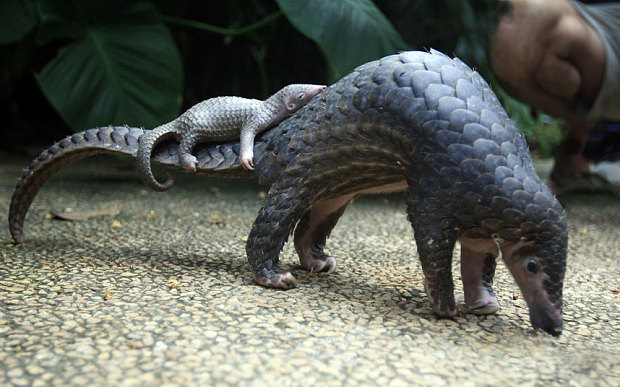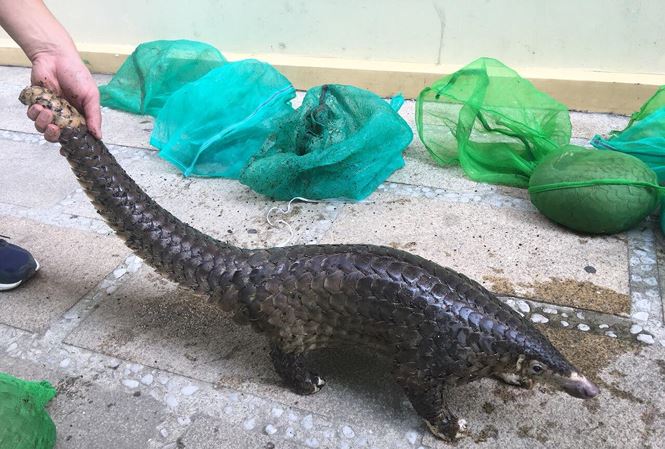Pangolin and five facts you may not know
Pangolins is facing extinction. Before taking action to protect this endangered animals from vanishing from our Earth, equipping yourself with some knowledges about pangolin is definitely a need.
 |
All eight pangolin species are protected under national and international laws. But there is still growing international illegal trade in pangolins. (source: Reuters)
Fact # 1: Rolling mammals
Though many think of them as reptiles, pangolins are actually mammals.
The word Pangolin comes from ‘penggulung,’ the Malay word for roller – the action a pangolin takes in self-defense. They are the only mammals wholly-covered in scales and they use those scales to protect themselves from predators in the wild. A startled pangolin will cover its head with its front legs, exposing its scales to any potential predator. If touched or grabbed it will roll up completely into a ball, while the sharp scales on the tail can be used to lash out.
The scales of pangolin is made of keratin (the same as human finger nails). These scales account for up to 20% of a Pangolin’s entire weight.
Pangolins are also referred to as 'scaly anteaters' because of their preferred diet - ants.
Fact # 2: How many species of pangolin?
Eight. Four species of pangolin can be found in Africa, and four in Asia.
The four species that live in Africa are: Black-bellied pangolin (Phataginus tetradactyla), White-bellied pangolin (Phataginus tricuspis), Giant Ground pangolin (Smutsia gigantea), Temminck's Ground pangolin (Smutsia temminckii).
The four species that live in Asia are: Indian pangolin (Manis crassicaudata), Philippine pangolin (Manis culionensis), Sunda pangolin (Manis javanica), Chinese pangolin (Manis pentadactyla).
Most pangolins inhabit tropical forests, dry woodlands and the savannah. Some pangolins spend their time up in trees and others sleep in burrows underground.
Cute pangolin pups hitch a ride on their mother’s tails for three months and remain in their mother’s care for five months before braving life solo.
Fact # 3: What do pangolins eat?
Pangolins eat ants, termites and larvae and are often known as "the scaly anteater." Because they have no teeth, pangolins pick up food with their sticky tongues, which can sometimes reach lengths greater than the animal’s body.
Pangolins have a long sticky tongue that grows from deep inside their chest cavity and can extend to over 40cm, which is longer than its own body! This tongue is a perfect tool for catching insects. One Pangolin is estimated to catch a massive 70 million a year.
With no teeth, and unable to chew, the insects are broken up by stones and keratin spines located inside their stomachs.
Fact #4: Why pangolins are among the most trafficked mammal in the world?
Despite its tough looking, this little mammal is on the edge of survival with some populations classified as Critically Endangered. They are the most trafficked animal in the world which has led to more than a million being stolen from the wild. The IUCN estimate that a Pangolin is taken from the wild every 5 minutes.
All eight pangolin species are protected under national and international laws, and two are listed as Critically Endangered on the IUCN Red List of Threatened Species.
In China and Vietnam, pangolins are highly prized by consumers for their meat and their unique scales.
Their meat is considered a delicacy and pangolin scales are used in traditional medicine and folk remedies.
While they are a potent defence against predators, their scales are useless against poachers, and all eight species in Asia and Africa are now under threat. If under threat, a pangolin will immediately curl into a tight ball and will use their sharp-scaled tails to defend themselves. In some cases, by cruel coincidence, when pangolin is touched, it will roll up completely into a ball it is this same defence mechanism that makes human capturing of the pangolins as easy as picking up a ball.
 |
Illegally trafficked pangolins in Vietnam. (source: DT News)
Over the past decade, over a million pangolins have been illegally taken from the wild to feed demand in China and Vietnam. Their meat is considered a delicacy, while their scales are used in traditional Chinese medicine as they are believed to treat a range of ailments from asthma to rheumatism and arthritis.
Based on reported seizures between 2011 and 2013, an estimated 116,990-233,980 pangolins were killed, which represents only the tip of the trade. Experts believe that seizures represent as little as 10 percent of the actual volume in pangolins in illegal wildlife trade.
Some lucky pangolins were rescued but the chance of survival is normally quite low, since while being trafficked, pangolins suffer from malnutrition, oxygene shortage, dehyration, stress, depression, etc.
Fact # 5: Is there any good news for pangolins?
Yes! In 2016, a treaty of over 180 governments announced an agreement that would end all legal trade of pangolins and further protect the species from extinction. Organizations like WWF, together with TRAFFIC, works to protect species from wildlife crime. They are putting efforts in reducing consumer demand for illegal wildlife products with campaigns and partnerships with governments and businesses.
In Vietnam, there is a program called Carnivore & Pangolins Conservation Program (CPCP) is operated and managed through a collaborative partnership between Cuc Phuong National Park and Save Vietnam's Wildlife and is recognised globally as a world leader in pangolin research and captive care. CPCP is dedicated to rescuing, rehabilitating and releasing back to the wild carnivores and pangolins confiscated from the illegal wildlife trade. It is also developing global conservation breeding programs for these threatened species./.
( VNF )
Recommended
 Handbook
Handbook
Vietnam Moves Up 8 Places In World Happiness Index
 Handbook
Handbook
Travelling Vietnam Through French Artist's Children Book
 Multimedia
Multimedia
Vietnamese Turmeric Fish among Best Asian Dishes: TasteAtlas
 Handbook
Handbook
From Lost to Found: German Tourist Thanks Vietnamese Police for Returning His Bag
Popular article
 Handbook
Handbook
Prediction and Resolution for the Disasters of Humanity
 Handbook
Handbook
16 French Films To Be Shown For Free During Tet Holiday In Vietnam
 Handbook
Handbook
Unique Cultural and Religious Activities to Welcome Year of the Snake
 Handbook
Handbook



